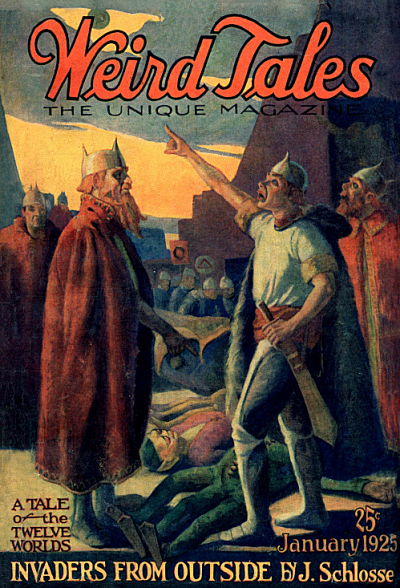INVADERS FROM OUTSIDE (9)
By:
November 3, 2023

J. Schlossel’s first story, “Invaders from Outside,” appeared in the January 1925 issue of Weird Tales. It was one of only six stories that he’d publish. SF historians agree that — with its solar system of inhabited planets, a council of worlds, and a space battle between fleets of ships — the story is an early example of “space opera.” HiLoBooks is pleased to serialize it here for HILOBROW’s readers.
ALL INSTALLMENTS: 1 | 2 | 3 | 4 | 5 | 6 | 7 | 8 | 9.
A low hum came from behind the cubes. It rose and rose. It came from the throats of the two-legged invaders. The sound was not displeasing. It gathered volume every instant. Though it was not very melodious at first, still it teemed with pathos. One by one the invaders joined in the song. It hinted of a mighty, daring attempt and of a bitter failure. It was their death song.
Meanwhile the invaders on No. 5 who had, through their great knowledge of stellar mechanics, guided their own world from out of the depths of space, were now working desperately in their attempt to install machines that would enable them to swing No. 5 out of its orbit. They had failed in their attempt to conquer the Confederation, and their only wish was to take No. 5 from out of the solar system and escape.
They were installing the machines underground. They threw up shield after shield to protect themselves from the death-dealing rays. Two out of every five machines that they installed were destroyed by the twin jets of light.
The number of invaders left on No. 5 was very small. In desperation they started the machines. The speed of No. 5 began to increase, and she was rotating faster, too. Something had gone amiss. The jets of light, in destroying nearly half of their machinery. had upset their calculations. The two-legged invaders on No. 5 were seen to run wildly about. They tried to stop the machinery that they had started, but somehow could not do so.
The rotation of No. 5 became still swifter. Hundreds of thousands of cubes were hurled into the heavens by the centrifugal force of that rotating world. The Confederacy picked off as many as it could with the crossing jets of light, but some managed to escape and were seen heading for Neptune. No. 5 was breaking up! The centrifugal force had become greater than its power of gravitation. Huge masses were seen to detach themselves and go whirling off into space.
Saturn, the largest body in the vicinity, was seen to draw fully one-third of the matter that had composed No. 5 in its general direction. The powerful gravitational force of the Sun drew many large pieces, some of which were more than eight hundred miles in diameter, toward himself. The Moon, circling the Earth, came from behind its protection and bore the brunt of a stream of small pieces that struck its surface. Life there was instantly destroyed. The surface of the Moon became partially incandescent. Parts of the Earth, thanks to the Moon, escaped practically uninjured. But there was only a wild kind of life existing there. Jupiter received its share. Two large fragments went hurtling toward Mars.
In destroying No. 5 the invaders had destroyed themselves and nearly all the life on the solar system. The survivors of the Twelve Confederate Worlds made their way to the Earth, the least injured of the planets, and there they began anew, in a strange environment, to build the civilization that had been wrecked by the invaders from beyond the Milky Way.
RADIUM AGE PROTO-SF: “Radium Age” is Josh Glenn’s name for the nascent sf genre’s c. 1900–1935 era, a period which saw the discovery of radioactivity, i.e., the revelation that matter itself is constantly in movement — a fitting metaphor for the first decades of the 20th century, during which old scientific, religious, political, and social certainties were shattered. More info here.
SERIALIZED BY HILOBOOKS: James Parker’s Cocky the Fox | Annalee Newitz’s “The Great Oxygen Race” | Matthew Battles’s “Imago” | & many more original and reissued novels and stories.
